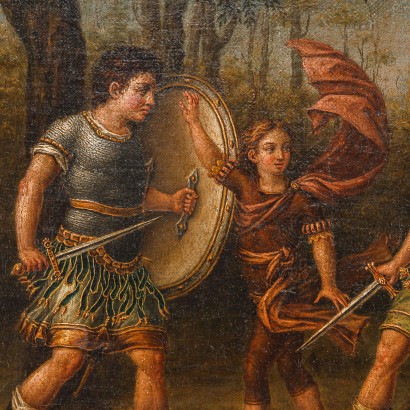Group of 4 Antique Paintings Oil on Canvas Italy XVIII Century
Features
Artwork title: Gruppo di Quattro Dipinti con Scene dell'Orlando Furioso
Artistic school: Lombard School
Age: 18th Century / 1701 - 1800
Subject: Scenes from an epic poem
Artistic technique: Painting
Technical specification: Oil on Canvas
Description : Gruppo di Quattro Dipinti con Scene dell'Orlando Furioso
Oil painting on canvas. Lombard area of the late 18th century. The four canvases show scenes from Orlando Furioso, the famous epic poem written by Ludovico Ariosto and published for the first time in 1516. On the frame, on the back, there are handwritten writings in ancient Italian, which say the title of the scene and they give the reference of the song and the verse. All four scenes represent episodes taken from the first two songs of the poem and appear to be sequential. The attributive titles are as follows: 1- “This painting represents that Paladin galiardo (Rinaldo) son of Amone sig. di Monte Albano, which describes Ariosto in canto 1 to verse 12 ”: depicts the moment in which Rinaldo, on foot of his horse Baiardo, sees Angelica escaped from the camp of Namo di Baviera in the wood. 2- "This painting represents Angelica and Ferraù when she comes to their aid, which Ariosto describes in canto 1 verse 14": Angelica fleeing from Rinaldo, meets in the woods Ferraù, a noble Saracen knight who is also in love with the girl, who helps to escape by opposing the Christian knight. 3- “This painting represents Rinaldo and Sacripante who fall down, Angelica runs away from their fury. Ariosto describes it in Canto 2 verse 10 ": Rinaldo and Sacripante fight to compete for the love of Angelica, who in the meantime runs away. 4- “This painting represents Rinaldo and Sacripante in the act they fell for Angelica and were stopped by a spirit in the form of a Valletto. Ariosto describes it in canto 2 verse 15 ": while the two knights fight, Angelica meets a hermit, who, with a spell, evokes a spirit with the appearance of a footman, who interrupts the duel between the two contenders. The paintings therefore belong to a single pictorial cycle, attributable to the end of the eighteenth century and which, in accordance with the neoclassical taste, represents the characters in classical clothes - warriors dressed as ancient soldiers, Angelica dressed in a Roman tunic, shoes and bracelet - , but inserted in a landscape of Northern Italy, a shady and dense forest. The Orlando Furioso had the peculiarity of proposing the warlike theme associated with the love one (in particular the love story between Angelica and Medoro was preferred, which became the subject of numerous works by artists of all centuries) and obtained great popularity and success: His representations were numerous in all ranges of visual pictorial art, in stately frescoes, paintings, ceramics, even apothecary jars, cups, medals, pendulums, candelabra. It began in the Emilian land, the homeland of the poem created by Ariosto for Cardinal Ludovico D'Este, to arrive at the Medici courts, in Lombardy, where subsequently Ariosto's pictorial cycles were carried out in numerous palaces and stately homes. The canvases are presented in gilded style frames.
Product Condition:
Product in good condition, with small signs of wear.
Frame Size (cm):
Height: 36,5
Width: 55,5
Depth: 2,5
Artwork dimensions (cm):
Height: 31,5
Width: 51
Additional Information
Artistic school: Lombard School
Age: 18th Century / 1701 - 1800
18th Century / 1701 - 1800Subject: Scenes from an epic poem
Artistic technique: Painting
La pittura è l'arte che consiste nell'applicare dei pigmenti a un supporto come la carta, la tela, la seta, la ceramica, il legno, il vetro o un muro. Essendo i pigmenti essenzialmente solidi, è necessario utilizzare un legante, che li porti a uno stadio liquido, più fluido o più denso, e un collante, che permetta l'adesione duratura al supporto. Chi dipinge è detto pittore o pittrice. Il risultato è un'immagine che, a seconda delle intenzioni dell'autore, esprime la sua percezione del mondo o una libera associazione di forme o un qualsiasi altro significato, a seconda della sua creatività, del suo gusto estetico e di quello della società di cui fa parte.Technical specification: Oil on Canvas
The oil painting is a painting technique using powder pigments mixed with bases in inert and oils.Other customers have searched:
Se sei un appassionato d'arte, non perderti i nostri approfondimenti sul Blog Arte Di Mano in Mano e su FineArt by Di Mano in Mano - Arte:
Leggi di più
Ecco alcuni tra i principali articoli:Vedute
Falsi nell'arte antica
Un messaggio di fiducia per ripartire
La potenza espressiva dell'arte figurativa etiope
Breve Storia del Collezionismo
Giorgio Upiglio, maestro dei libri d'artista
Matthias Withoos detto "Calzetta bianca"
San Rocco pensaci tu - Classic Monday
Dai un'occhiata alle nostre rubriche di divulgazione sull'arte:
Epoche
Lavorazioni e tecniche
Mostre ed Eventi
Protagonisti
Se sei appassionato di pittura antica, con tutta probabilità gusterai le schede di questi stupendi quadri:
"Dio parla a Noè dopo il diluvio", Jacopo da Ponte, detto il Bassano, seconda metà XVI secolo
Crocifissione, maestro della misericordia dell'accademia, terzo quarto del XIV secolo
Erminia incontra i pastori, Camillo Gavassetti, Seconda metà anni Venti del XVII Secolo
Eroine dell'antichità, Francesco Conti, XVIII secolo
Hieronymus III Francken, La Negazione di Pietro, XVII secolo
Jefte e la figlia, Girolamo Forabosco e aiuti, XVII secolo
L'Accademia di Platone, piccolo arazzo, fine XVII - inizio XVIII secolo
Maddalena e San Giovanni Battista
Natura Morta, Bartolomeo Arbotori, XVIII secolo
Sacra Famiglia con San Giovannino, Bartolomeo Ramenghi, scuola di, prima metà XVI secolo
Testa Femminile, Andrea del Sarto, ambito di, post 1522
Uva, fichi, melagrana e pesche su un capitello - Maximilian Pfeiler, primo quarto XVIII secolo
Sapevi che l'arte può essere anche un ottimo investimento (e non solo per grandi portafogli)?
L'Arte tra Collezionismo e Investimento
FineArt: Arte come investimento





































